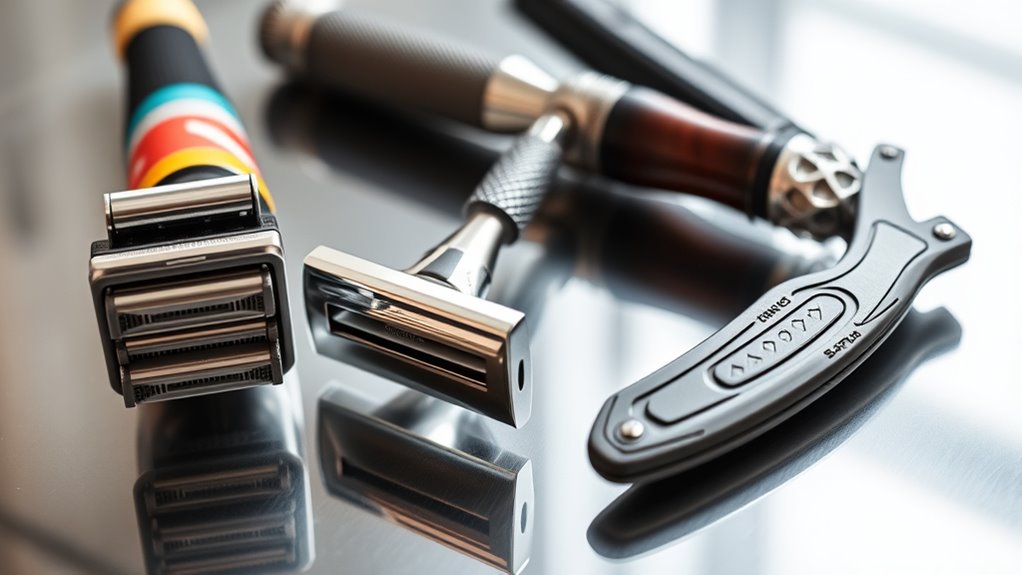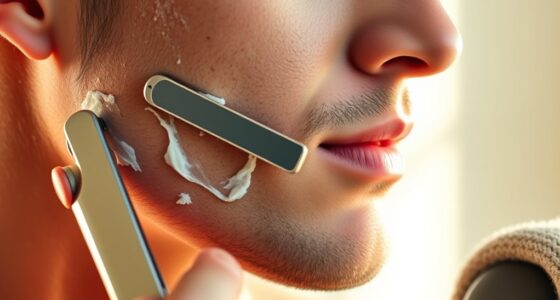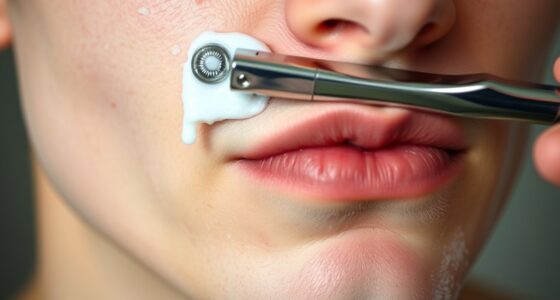Choosing between cartridge, DE (double-edge), and straight razors depends on your skill, skin type, and style preference. Cartridge razors are quick and easy, perfect for everyday use, but they may cause irritation over time. DE razors offer a close shave with less irritation and are more environmentally friendly, though they need some skill. Straight razors provide unmatched control and precision but require practice. Keep exploring to find the best fit for your grooming routine.
Key Takeaways
- Cartridge razors are convenient and easy to use, with disposable or replaceable blades, suitable for quick daily shaving.
- Double-edge (DE) safety razors offer close shaves with recyclable blades, requiring skill but providing cost efficiency and less irritation.
- Straight razors are traditional, high-precision tools made from high-quality steel, needing honing and stropping for maintenance.
- Blade material, coating, and ergonomic handle design influence comfort, control, and shave quality across all razor types.
- Choosing the right razor depends on skill level, skin sensitivity, desired closeness, and maintenance preferences.

Have you ever wondered which type of razor is best for your shaving needs? Choosing the right razor depends on understanding the different styles and what they offer. Cartridges, safety razors, and straight razors each have their unique advantages, but your decision should be based on factors like blade materials and ergonomic design. These elements influence comfort, precision, and overall shaving experience.
Starting with cartridge razors, they’re popular because of their convenience and ease of use. Their blades are typically made from stainless steel, guaranteeing durability and resistance to rust. Some higher-end cartridges incorporate multiple blades, often with coatings of platinum or chromium, which help reduce irritation and provide a smoother shave. The ergonomic design of cartridge razors is crafted to fit comfortably in your hand, allowing you to maneuver easily around contours and tricky spots. The handle’s shape, grip material, and weight distribution all contribute to reducing fatigue during shaving. Because of their design, cartridge razors are suitable for everyday use, especially if you prefer a quick, fuss-free shave. Their replaceable blades mean you don’t need to sharpen or hone them, making maintenance simple.
Cartridge razors are convenient, with stainless steel blades and ergonomic designs for easy, everyday shaving.
Safety razors, also known as double-edge (DE) razors, offer a different experience. The blades used in DE razors are usually made from high-quality stainless steel, sometimes coated to enhance smoothness and longevity. These blades are thinner than cartridge blades but very sharp, providing a close shave with less skin irritation when used correctly. The ergonomic design of safety razors is vital; the handle is often textured or contoured to give you a firm grip, giving you control over the shave’s pressure and angle. This precision helps prevent nicks and cuts, especially if you’re experienced. Safety razors are more environmentally friendly since you only replace the blades, which are small and recyclable. They’re also cost-effective over time, though they require a bit more skill and patience to master. Additionally, the blade materials used in safety razors can vary, impacting sharpness and durability, which influences your overall shaving experience.
Straight razors, often seen as the traditional choice, demand the most skill but reward you with unmatched closeness and control. The blades in straight razors are made from high-quality steel, with craftsmanship focusing heavily on blade materials and sharpness. The handle, or scale, is designed with ergonomics in mind, often made from wood, leather, or synthetic materials that feel comfortable in your hand. Proper ergonomic design ensures you can maintain stability and control during each stroke. Straight razors require honing and stropping to keep the blade sharp, but many enthusiasts appreciate the craftsmanship involved. They’re perfect for those who want a traditional, precise shave and are willing to invest time and effort into mastering the technique.
In the end, your choice of razor depends on your skill level, skin sensitivity, and personal preferences. Understanding how blade materials and ergonomic design influence your shave can help you pick the perfect tool for your grooming routine.
Frequently Asked Questions
Which Razor Type Is Best for Sensitive Skin?
For sensitive skin, a DE razor often works best since it offers gentle, precise shaves and lets you choose blades with better longevity. You might also consider eco-friendly options like safety razors, which use replaceable blades and reduce waste. These razors give you control over blade sharpness and pressure, minimizing irritation. Ultimately, finding the right razor depends on your skin’s reaction and preferences, but these options tend to be gentler for sensitive skin.
How Often Should I Replace the Blade in Each Razor Type?
Your blade lifespan is like a ticking time bomb—once it’s past its prime, it’s ready to betray you. For cartridges, replace the blade every 5-7 shaves. Double Edge (DE) blades last around 7-10 shaves before dulling. Straight razor blades need replacement or honing after about 20-30 shaves. Keep track of your replacement frequency to maintain a smooth, irritation-free shave and avoid unnecessary nicks and cuts.
Are There Eco-Friendly Options for Cartridge Razors?
Yes, you can choose eco-friendly options like biodegradable blades and recycled razor handles. Biodegradable blades break down naturally, reducing landfill waste, while recycled handles use less new material. Look for brands that promote sustainability, and consider switching to these greener alternatives. You’ll enjoy a smooth shave while helping the environment, making it a win-win for both your grooming routine and the planet.
Can I Use a Straight Razor for Body Grooming?
Yes, you can use a straight razor for body grooming, but it’s like steering a ship through rough seas—requires skill and caution. Unlike electric shavers or beard trimmers, straight razors demand more precision and care. They’re perfect for close shaves, but you’ll want to guarantee cleanliness and technique to avoid nicks. If you’re confident, it’s a traditional, eco-friendly choice that delivers a smooth finish.
What Maintenance Is Required for a DE Safety Razor?
You need to regularly clean and dry your DE safety razor after each use to prevent rust and buildup. Keep the blades sharp by replacing or honing them when dull, ensuring a close shave. Store your razor in a dry, ventilated area to avoid corrosion. Occasionally, check the blade for sharpness and replace it if needed, and always handle blades carefully during replacements to prevent injuries.
Conclusion
Now that you’ve explored the different razor types—cartridge, DE, and straight—you can picture each as a tool in your grooming arsenal. Think of them like paints on a palette, each offering unique strokes for your personal style. Whether you prefer the quick, precise swipe of a cartridge, the nostalgic charm of a DE, or the mastery of a straight razor, your choice shapes your grooming story. Pick your brush, and craft your signature look with confidence.









